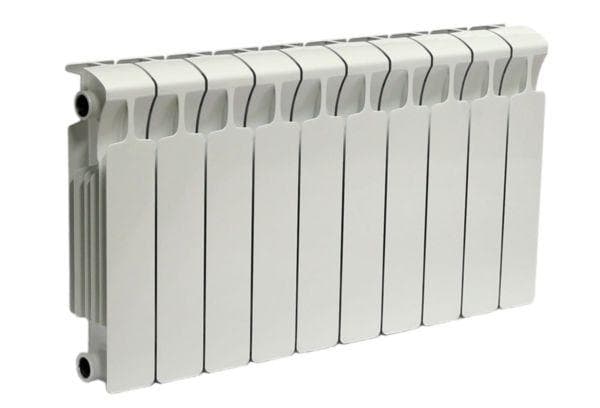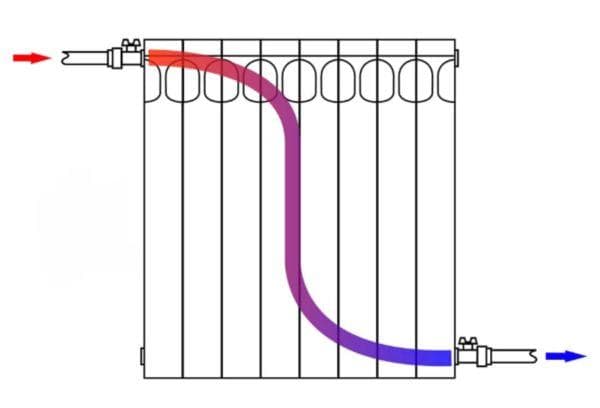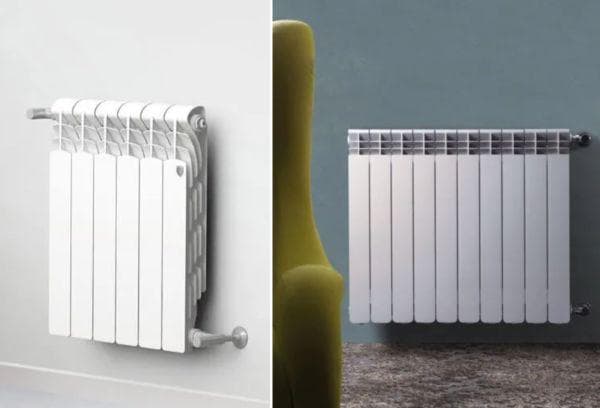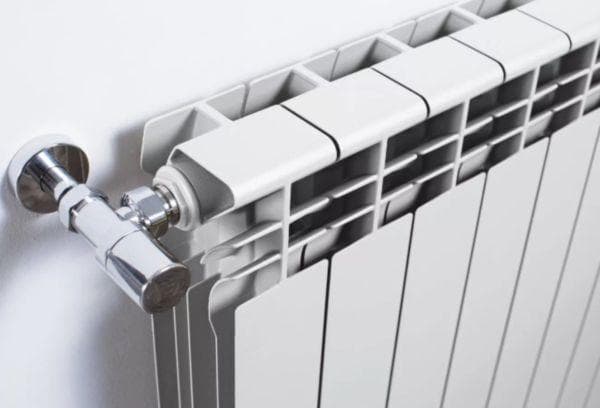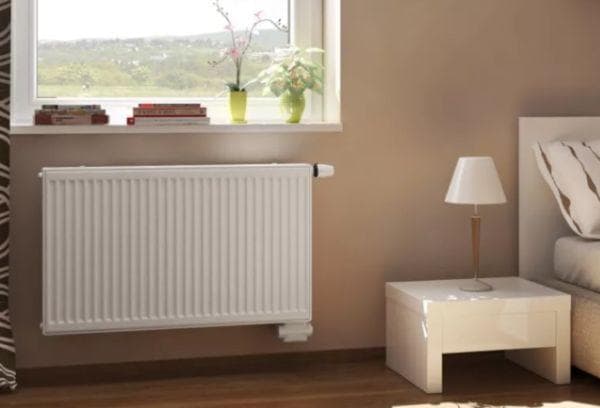The difference between bimetallic radiators and aluminum ones. How to assemble a reliable heating system and not overpay
Content:
Which radiator is better, aluminum or bimetallic? These two options are more popular than steel or cast iron batteries. But why do experts recommend aluminum and bimetallic structures? What are their features, advantages and disadvantages? How to choose the right radiator and not spend thousands of rubles on repairs? Let's find out.
What is an aluminum radiator
Aluminum for batteries is not the same metal from which buckets and pans are made. Special components are added to the alloy to increase heat transfer and improve corrosion resistance.
Batteries made of this metal look “complex” - they are made of a large number of thin elements. This petal design increases heat transfer: the device works both as a sectional radiator and as a convector.
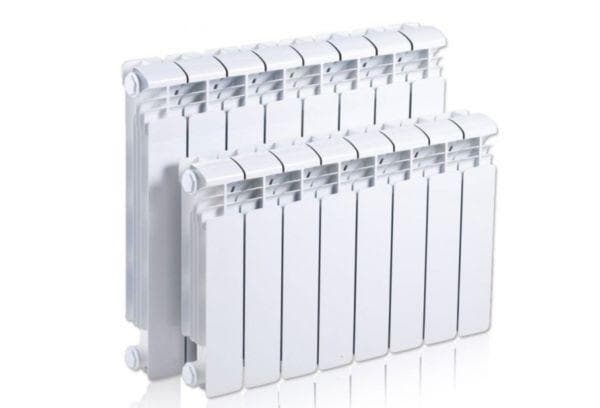
The best radiators are made from aluminum alloy - silumin. It contains about 12% silicon - this provides products with high strength.
Each section of such radiators is cast under pressure and then welded in an inert gas environment.
A simpler and cheaper option is extrusion models. Such products are not cast; they are extruded through an extruder under high pressure. The parts are then press fit with the upper and lower manifolds cast. This method of connecting parts is unreliable. If pressure builds up in the system, the extrusion cooler may burst.
If you are unlucky with the manufacturer, the seams will come apart even with careless installation.
Cheap Chinese models are even worse. The battery parts are not pressed into them, but are attached to composite glue.
Advice. Pay attention to the manufacturer's reputation. Don't save money, choose proven brands with good reviews.
What is a bimetallic radiator
The bimetallic structure consists of two parts:
- a steel pipe frame through which the coolant flows.
- The aluminum body is the one that, when warmed up, releases heat into the surrounding space.
This design combines strength and high thermal conductivity.
The principle of operation is simple: the coolant moves along the steel core and warms it. Heat from the steel is transferred to the external ribbed structure, and then to the environment.
Some radiators have internal cores made of copper. This is the most reliable and most practical option. Such batteries will even withstand antifreeze in the coolant. But on the Russian market, radiators with a copper core are rare.
There is also a compromise option - semi-bimetallic models. Their core is made of two metals:
- vertical channels are made of steel.
- horizontal – aluminum.
This design has higher heat transfer than classic bimetallic options.But there are two problems:
- alkaline or too acidic water will cause corrosion in aluminum tubes;
- aluminum and steel have different thermal expansion - which means the cores can move, and this will affect the operation of the system.
Therefore, semi-bimetallic models are rarely installed. They are more expensive than aluminum and retain all of its key disadvantages.
What is the difference?
Visually, aluminum and bimetallic structures are very similar. They can only be distinguished by weight - metal is heavier.
But there are also design differences.
- Manufacturing technique. Aluminum radiators are cast as a single product, which means they are solid. A bimetal is a structure connected from two different elements.
- Contact with coolant. In aluminum batteries, the filler flows through channels made of aluminum alloy. In bimetallic, the coolant moves through steel tubes that are filled with aluminum alloy. There is no direct contact with the outer surface.
- Internal section. Two-component batteries have a smaller core diameter.
The pros and cons of radiators depend on differences in design.
comparison table
Let's collect all the features of radiators in one table.
| Characteristic | Aluminum batteries | Bimetallic batteries |
| Thermal conductivity | + | — |
| Low inertia | + | — |
| Response to thermostat commands | — | + |
| High pressure resistance | — | + |
| Corrosion resistance | — | + |
| Weight | + | — |
| Internal cross-sectional area | + | — |
| Easy to install | — | + |
| Life time | — | + |
| Price for 1 section. Economy option. | 300 rub. | 400 rub. |
The price difference is small, but the table shows the cost of only one section. Let's assume that there are 10 such sections in one battery. Then the difference in price will be 1000 rubles. For three rooms this is already 3000 rubles.
Please note: we indicated the price of radiators “net” - only for the device. Some manufacturers include insurance in the price, others - a warranty. There are companies that do both – in this case the price increases. The installation company can add its own markup, which will further increase the cost.
Pros and cons of aluminum radiators
These devices are universal: convenient, economical, effective. But they also have disadvantages.
Advantages
Let's analyze the advantages of aluminum.
- High thermal conductivity.
For aluminum, this figure is 2-4 times higher than for bimetallic devices, steel or cast iron.
- Compact sizes.
Since aluminum has high heat transfer, the size of radiators can be reduced by 2-3 times. And this will not affect the temperature in the room at all.
- Aluminum has low inertia - batteries heat up easily and cool down easily.
This is convenient when you want to quickly change the temperature in the room. To control the heating level of the batteries, install thermostats on them. This way you will not depend on the temperature of the coolant in the system.
- Radiators have a wide range of operating and pressure testing.
Such devices are universal - they are installed in both open and closed systems.
- Low weight.
Radiators are easy to carry and install.
- A large number of design solutions.
There are a lot of models on the market, and if you wish, you can order radiators according to your own sketch.
Flaws
Aluminum also has disadvantages.
- Sensitivity to the pH level of the coolant.
If your house has too acidic water flowing through the pipes, the batteries will begin to rust. Hence the problems with European radiators.Many Russians complain that appliances that were supposed to last 20-30 years began to rust after 5 years of use.
- Fragility.
The best manufacturers provide a 15-year warranty on radiators. This is less than competitors.
- There may be problems with installation.
Aluminum is a soft metal. During installation, an inexperienced technician may damage the structure.
- Hydrogen may be generated upon contact with coolant.
Install automatic air vents on all batteries and the problem is solved.
Hydrogen is non-toxic and is part of the air we breathe. But upon contact with fire, pure hydrogen explodes. Therefore, under no circumstances check the presence of hydrogen in the system with a match.
Pros and cons of bimetallic radiators
These radiators are more expensive - and the high price is justified. Two-component batteries have many advantages, but few disadvantages.
Advantages
The basis of bimetallic structures is steel pipes. Hence the main advantages of these radiators.
- High anti-corrosion resistance.
Bimetallic structures will withstand both the high pH of the coolant and the presence of oxygen in the system.
- High strength.
The metal will withstand both high pressure in the system and water hammer - this is the name for sudden surges in pressure. They occur when pumps are stopped or started. High-quality batteries have a maximum strength level of up to 50 atm, and the most severe water hammer in the system does not exceed 25 atm.
- High inertness compared to aluminum.
Bimetallic pipes cool slowly - in some cases this is a plus.
- Quickly respond to thermostat commands.
Since the internal diameter of the bimetallic structure is lower, less coolant fits into it.The smaller the volume of liquid, the faster it will heat up or cool down.
- Durability.
High-quality products will last you 20-30 years.
Flaws
There are only two disadvantages to two-piece radiators.
- Low cross-sectional area.
Metal pipes are narrower, which means they are more easily clogged with rust and calcium deposits.
- The prefabricated structure is less reliable.
This radiator consists of two structural elements: steel pipes inside, and an aluminum “jacket” outside. This means that connections may become disconnected. This happens rarely and only with low-quality batteries, but still keep this point in mind.
What is better to choose
The difference between bimetallic and aluminum radiators is not that big. To make the right choice, answer a few questions.
- Is the system filled with high-quality coolant?
If the pH is normal and there is no oxygen in the liquid, install any radiators. But if the coolant is chemically aggressive, only a bimetallic structure will withstand contact with it.
- Do you have spacious rooms?
If yes, you can choose any option. No? Then install aluminum. Radiators made of this metal provide excellent heating, but are 2 times smaller in size than their analogues.
- Does your heating often turn off in winter?
If this happens, choose bimetallic batteries. They retain heat well, which means the room will remain warm for a long time. Aluminum will cool down in 20-30 minutes.
- Is the pressure in the system stable, or does water hammer occur?
If there are sudden pressure surges, choose a design with steel elements - it is stronger.
For a private home, this problem is not relevant - the pumps in the system are too weak, the operating pressure rarely exceeds 3 bar. Any radiator can withstand such a load.
- Is the coolant clean?
In some cities, rusty, highly mineralized water is pumped into the system. Such liquid will quickly clog narrow pipes, which means that two-component batteries are not suitable. Choose aluminum ones - they have a wider internal cross-section.

Why experts do not advise clients to use cast iron batteries
Cast iron radiators used to be everywhere, but now they are rare. There are many reasons:
- High inertia.
Cast iron heats up slowly and cools just as slowly. This is good if the heating in the house is often turned off. But if not, you will not be able to regulate the temperature in the room. It will take more than an hour for the thermostat to respond to commands.
- Heat transfer from cast iron is lower.
To ensure a comfortable temperature, more cast iron sections will have to be installed.
- These radiators are very heavy.
And the problem is not transportation. Not every wall will support the weight of a cast iron battery of 10-12 sections. Such radiators can destroy even a bulk wall, let alone drywall.
- Few design solutions.
Many cast iron batteries look like “relics”. It is good if the interior of the room is made in a retro style. But if you prefer more modern design options, cast iron will not fit into them.
What's wrong with steel radiators
Another option that is on the market, but is not popular. Steel batteries:
- They rust easily.
An acidic or alkaline environment will kill such batteries. You can’t even drain water from them - air will fill the voids, and the walls of the radiators will begin to rust from the inside.
Narrow passage area.
Contaminated rusty coolant will quickly clog the internal cores.
- Unresistant to hydraulic shocks.
Steel batteries cannot be installed in buildings with 9 floors or higher.If the system malfunctions, you risk flooding your neighbors below with hot water.
Advice from an expert
In order not to bother, thinking about a dozen parameters, answer one question: do you install batteries in an apartment or in a private house?
High-rise building
The coolant in the system moves under significant pressure; oxygen is often added to the liquid for enrichment. The acidity level of the coolant should not exceed 7-9 pH, but in some cases it rises to 11-12 pH, and this is not the limit. Water hammers in the system also happen. This means that the safest option is bimetallic structures.
A private house
You fill the pipes with coolant yourself and personally control the quality. There are no water hammers in the system, the operating pressure is consistently low. So why overpay? Install more economical aluminum structures.
But if you want bimetallic batteries, this is your choice. They will be just as effective, they will just cost more.
As you can see, it is impossible to say unequivocally which is better, bimetallic or aluminum radiators. It all depends on the situation. Analyze the circumstances, weigh everything and make the right choice.
